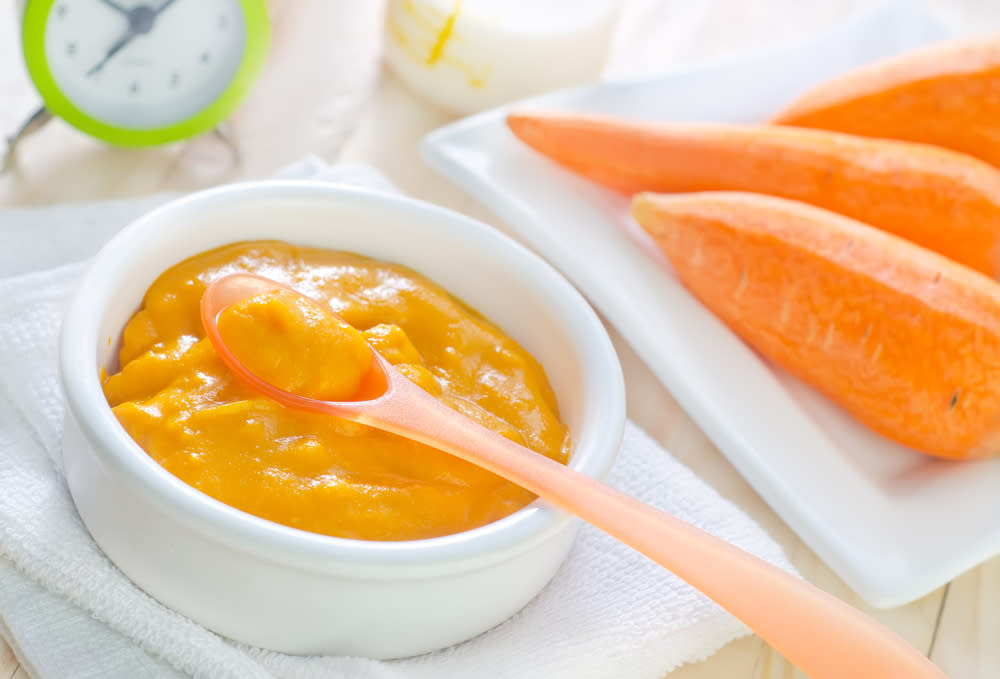Lead & Arsenic Found in Fruit Juice and Baby Food. Here's What You Need To Know

February 4, 2019
According to two reports, heavy metals including lead are present in fruit juice and baby food in amounts that may be concerning.
Consumer Reports just released findings showing "elevated levels" of lead, arsenic, and cadmium in nearly half of the 45 juices they tested, including apple, grape, pear, and fruit blends.
About half of the juices reached a threshold that CR's experts say is worrisome. Seven had levels they claim are high enough to be potentially harmful if kids drink more than 4 ounces (a half-cup) a day. Grape juice and juice blends had the highest load of these heavy metals, and organic juices were just as likely to contain heavy metals as conventional. They found these metals in both name brands and store brands of bottled juices, juice boxes, and juice pouches.
RELATED: How to Choose the Best Baby Food
An earlier report from the Environmental Defense Fund (EDF), a non-profit group, also raised concerns about lead in fruit juice. They found that baby food versions of apple and grape juice had more detectable levels of lead than standard versions.
In analyzing FDA data, EDF also reported that lead was detected in 20 percent of baby food samples (versus 14 percent for other foods). Lead was most commonly found in root vegetables including sweet potatoes and carrots, and cookies including arrowroot cookies and teething biscuits. Earlier CR testing found lead, arsenic, and cadmium in baby and toddler foods such as purees, cereals, puffs, and toddler meals (including organic versions).
The Juice Products Association, a trade association for the fruit and juice products industry, says CR's science is shaky. According to a statement they issued, CR isn't being transparent and has declined to disclose the amounts of heavy metals they found in juices. They say the report "needlessly and irresponsibly alarms consumers."
In the case of the EDF report, none of the samples had lead amounts higher than the FDA's allowable levels. The FDA has been monitoring the amount of lead in food for decades and reports that the vast majority of foods analyzed between 2005-2013 (88 percent) had levels too low to even be identified.
But the EDF and others say the FDA needs to update the allowable limits based on the current science showing there is no safe blood level of lead. "The FDA limits are decades old and don't reflect what we know now," says Jennifer Lowry, M.D., chair of the American Academy of Pediatrics (AAP) Council on Environmental Health and Chief of Medical Toxicology at Children's Mercy Kansas City. "It's now recognized that lead is more toxic than we thought."
Heavy metals can be dangerous to growing bodies and brains. According to the AAP, even low-level exposure to lead is a risk factor for decreased IQ and academic ability and for behavioral problems such as hyperactivity, aggression, and inattention. Lead's effects on the brain are permanent.
Unfortunately, it's impossible to completely avoid substances like lead and arsenic because they're present in the environment. They find their way into food and drinks when plants absorb them from soil and water. Lead may also leach into food from lead-containing food processing equipment, or food may come into contact with lead-based paint in buildings during handling.
If these reports concern you, here's what you can do:
Feed your child a variety of foods. That's the best defense against overexposure to anything. And don't avoid healthy fruits and vegetables because of the EDF report, says Dr. Lowry. For example, though sweet potatoes and carrots were singled out, those veggies also pack lots of good nutrition. So continue to serve them but offer lots of other kinds of veggies too. (Keep in mind that making your own baby food doesn't erase the risk since there's no way to know if the fresh fruits and veggies you buy at the store contain lead. If you grow your own produce, you can have your soil tested for the mineral).
Follow the AAP's latest guidelines for juice. That will help reduce exposure and establish healthy habits for your child. The AAP advises not serving juice to babies younger than one, giving no more than 4 ounces a day to children ages 1-3, no more than 4-6 ounces for kids 4-6, and no more than 8 ounces beyond that.
Reach out to your favorite brands and ask them whether they regularly test for heavy metals and what they're doing to reduce contamination. In a statement responding to the NDF report, Gerber says it regularly checks its water quality and tests foods and beverages "to ensure they fall well within all available guidance levels from the FDA".
Sally Kuzemchak, MS, RD, is a registered dietitian, educator, and mom of two who blogs at Real Mom Nutrition. She is the author of . She also collaborated with Cooking Light on
, a cookbook for busy families. In her spare time, she loads and unloads the dishwasher. Then loads it again.


